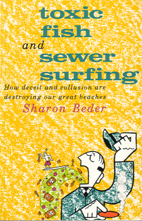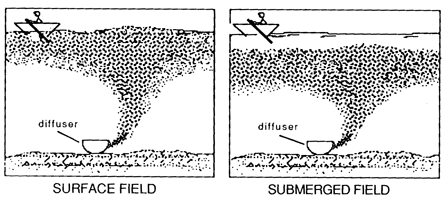
by Sharon Beder
first published by Allen & Unwin, Sydney, 1989
Introduction
Sewers seaward
Toothless watchdog
Toxic fish
Sewer-side surfing
Public relations battle
Events of 1989
Beyond Sydney
Conclusion
Bibliography
Sydney’s extended deepwater outfalls are supposed to reduce health risks because of extra dilution and dispersal. But just how effective are they? Between 1976 and 1981 the Australian Atomic Energy Commission (AAEC) carried out work for the Water Board to study ocean dispersion of sewage. Using a radioisotope, gold-198, the AAEC was able to label sewage solids before discharge into the ocean and then monitor their progress. The AAEC recognised that some materials such as grease, wax, scum and bacteria and other particles might accumulate rather than disperse. It found that grease was extremely persistent in the ocean and did not dilute much even five kilometres from the discharge point. Seven days after discharge the tracer was found in the same concentration as at the beginning. Wax and grease interfered with the dispersion and purification of enteric bacteria, which survived in grease accumulations because predators, oxygen and sunlight could not get to them. So the presence of grease on beaches was not just an aesthetic problem, it also indicated a health problem. The AAEC suggested the extended deepwater outfalls might have little benefit, especially since there may be less diffusion further from shore because there is less turbulence. The AAEC concluded that extended outfalls might cause more pollution because the sewage would reach more beaches and some of those beaches would not have natural predators of bacteria.
Under appropriate conditions, it only takes as few as ten bacteria or a single virus to induce an infection or disease in a person. A single ingested particle can contain a large dose of micro-organisms because of the tendency for particles to collect and protect viruses and bacteria on their surfaces. It is of no consolation to a swimmer who swallows such a particle that there are few such particles per litre of water. Already, in the United States, the Office of Technology Assessment has warned that the routine discharge of sewage is introducing large numbers of viruses and bacteria into coastal waters and that overall concentrations of these disease-causing organisms may be increasing.
So much for dilution. But apart from this, Caldwell Connell, the Sydney Water Board's consultants, stated in their 1976 report that bacteria and viruses would die of in the hostile seawater environment or be consumed by marine organisms. Their studies, however, only investigated the die-off rates of faecal coliform, which are harmless bacteria living in the human gut and used as an indicator that sewage is present.
At the time of writing their report Caldwell Connell were well aware of the inadequacies of faecal coliforms as a measure of health risk. They admitted that there was very little evidence that related faecal coliform concentration to the incidence of water borne disease and recognised that a specific faecal coliform limit did not define the line between a safe and hazardous water. They defended the use of faecal coliforms to indicate pollution of sewage origin because it was not ‘practicable’ to routinely monitor pathogenic organisms directly.
Yet they still used faecal coliforms as the focus of their study into the die-off rates of pathogenic organisms in the ocean. They did this ‘as a matter of convenience’, although they admitted that different organisms could be expected to have different die-off rates. Another reason was that the deepwater outfalls had to conform with SPCC guidelines, and these were in terms of faecal coliforms. The irony is that their experiments serve only to discredit faecal coliforms as an indicator of sewage in the sea, because they die of so quickly. The Water Board found that 90 per cent of faecal coliforms die of in one to seven hours during the daytime. So sewage that has been in the sea for more than an hour will not necessarily contain them. But it may contain something much nastier, like viruses. These, Caldwell Connell said, were difficult and costly to test for, and required specialist assistance. So they were not investigated at all.
In 1987 the US Office of Technology Assessment report pointed to ‘a growing body of evidence’ that viruses may persist in the marine environment for periods of many months and perhaps longer. Viable human pathogenic viruses were discovered in water, crabs and bottom sediments of an old sludge dump site in the Middle Atlantic of the east coast of the US, that had been disused for seventeen months. An outbreak of cholera along the Gulf coast of Texas was traced back to agents that survived in the coastal waters for at least five years.
Some viruses and parasites are very resistant to environmental degradation. Sometimes the colder temperature towards the bottom of the sea can help them survive while inhibiting their growth. As well as being protected by sludge or suspended sewage particles, viruses and bacteria can also be protected in grease balls, as discussed earlier in this chapter. Because some of these viruses are inactivated they cannot be cultured in the laboratory and they cannot be detected with traditional tests. But they can be reactivated in a human host.
The Water Board’s consultants do not seem to have researched what has been written on viruses despite their admitted lack of expertise, nor have they made any efforts to back up their assumptions about viruses being shortlived. Moreover, they did not supply any evidence that the die-off would be greater with the new ocean outfalls than it was with the existing ocean outfalls. The extra distance the sewage will have to travel to get to the shore only adds a few hours, if that, to the travel time. (This may be long enough for large numbers if faecal coliforms to die-off but not for many viruses.) Also, if the sewage is submerged the reduced exposure to sunlight could cancel out this small advantage. It seems their primary concern was not with ensuring that the extended outfalls posed no health threat to bathers but rather with whether they would comply with SPCC standards, which are in terms of faecal coliforms.
The international experts brought to Sydney to evaluate the extended outfalls in 1983, Brooks and Harremoes, were uncertain whether even the existing SPCC standards would be met in the winter despite the looser standards prescribed for winter. Both men believed that coliform requirements would be met in the summer period ‘provided the sewage held is kept submerged . . . for well over 90 per cent of the time’. As to Caldwell Connell's prediction that this would happen 96 per cent of the time, they were not prepared to back that up. ‘With the data presented, we are unable to judge whether the consultants’ predictions of frequency of shoreline impact are conservative or not. To demonstrate compliance with the 90 per cent requirement, more careful attention to infrequent events is required’ (P. Harremoes and N.H. Brooks, ‘Summary Report on Ocean Outfalls,’ 6/7/83). Brooks in particular believed that when the sewage field surfaced in winter faecal coliform counts on shore would exceed the standards. Moreover, they both thought it was possible that unusual situations, such as storms or transition seasons, could cause high readings if faecal coliforms for more than 10 per cent of the time during the summer bathing season and Brooks thought that disinfection on an intermittent basis might be required as it was for other overseas outfalls.
The extended outfalls were also designed to achieve a submerged sewage field. This is important, according to Caldwell Connell, for aesthetic reasons and to prevent sewage from reaching the beaches. The theory is that the sewage is released to mix with the cooler, denser layers at the bottom of the ocean, where it will be trapped below the warmer and less dense layers at the top.

This was first observed to occur on the west coast of the US. The waters of California have the top layers warmed by the sun and the bottom layers cooled by a cold current coming down from the north. However, Sydney stratification may be a 1ot less significant. According to Robert Brain, ‘The East Australia Current is warm and inhibits stratification; further in the vicinity of Sydney it tends to form back-eddies which may recirculate sewage. It does not follow, therefore, that a successful Californian design will transplant to Australia with equally good results’ (Brain, 1982). Brain, one of the SPCC’s engineers and the person first charged with evaluating the Water Board’s proposal, argued that a submerged field would only be achieved for short periods during the summer months and even then grease and floatables would surface and be subject to onshore surface currents. When there was a surface field conditions at the beaches would be even worse than existing conditions. The Board itself admits that the held would not be submerged for much of the time in winter. In the worst winter months the field will not be submerged any of the time and at North Head during the winter period as a whole the field will only be submerged 9 per cent of the time.